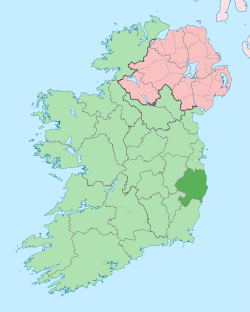Stratford-on-Slaney
Stratford-on-Slaney (Irish: Áth na Sráide, meaning "Ford of the Street"), also known as Stratford or Stratford-upon-Slaney, is a small village on the River Slaney in west County Wicklow in Ireland.
History
Stratford was founded by the Irish Stratfords in 1775 (and specifically by Edward Stratford, 2nd Earl of Aldborough), as a model cotton producing town. As well as the cotton mill the town included a hospital, Catholic, Protestant and Presbyterian churches and 14 Taverns. Despite huge investment, the industrial venture failed and Stratford practically disappeared following the demise of the cotton industry. In 1837, before the Great Famine, the village had a population of 3,000
The population has remained constant at approximately 200 over the past number of decades. Its streets are wide in a cross shaped layout. The village has panoramic views of the Wicklow Mountains form its hillside elevation 600 ft above sea level. The village has been Wicklow’s most tidy village on numerous occasions over the years and represented Ireland in a European wide floral competition.
Samuel Lewis' description
According to Samuel Lewis' 1837 Topographical Directory of Ireland Stratford was
| “ | a market-town and a parochial district, in the barony of Upper Talbotstown, county of Wicklow, and province of Leinster, 2 ¼ miles (N. N. E.) from Baltinglass (to which it has a penny post), near the road to Wexford, through Tullow; containing 2833 inhabitants, of which number, 952 are in the town. This town, which is of recent date, owes its origin to Edward, late Earl of Aldborough, who, towards the close of the last century, conferred upon it his family name, "Stratford," and distinguished it from other places of that name by the adjunct which describes its situation on the Slaney.
A battle was fought here during the 1798 Rebellion. It is built on the summit of a considerable hill rising from the bank of the river, and is regularly laid out in streets and squares, and commands most extensive views, including the windings of the river. Adjoining the town, on the bank of the river, are extensive cotton and calico printing works, established in 1792, by Messrs. Orr and Co., the present proprietors; they employ from 800 to 1000 persons: the machinery is worked by water power, and the average number of pieces printed and finished weekly is about 2000. The market is on Tuesday and Saturday, and by the patent the town is entitled to two annual fairs, which have never yet been held. |
” |
People
See also
External links
Coordinates: 52°59′N 6°41′W / 52.983°N 6.683°W
